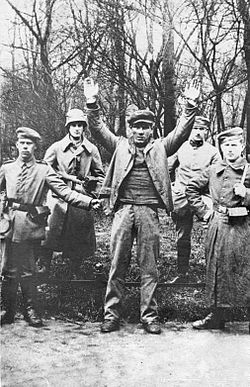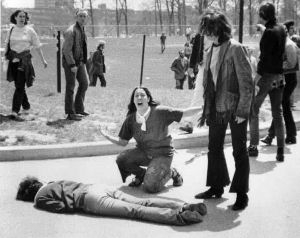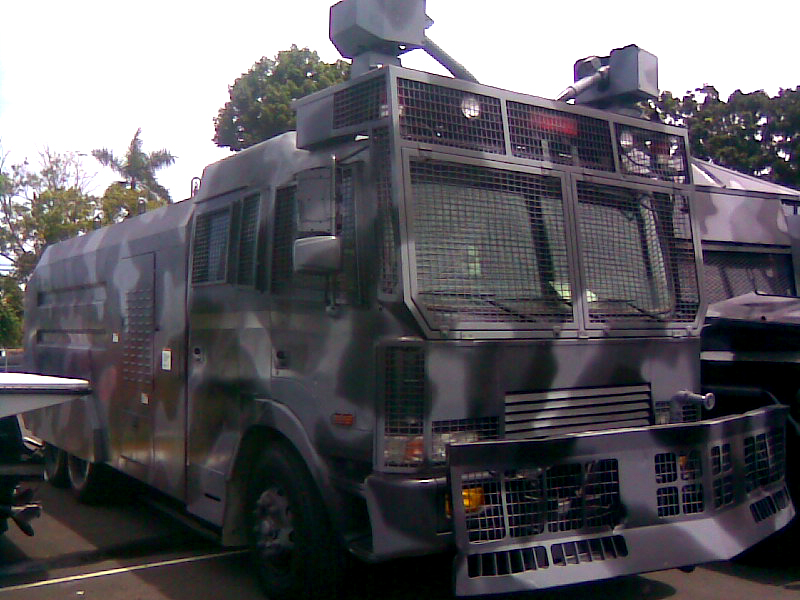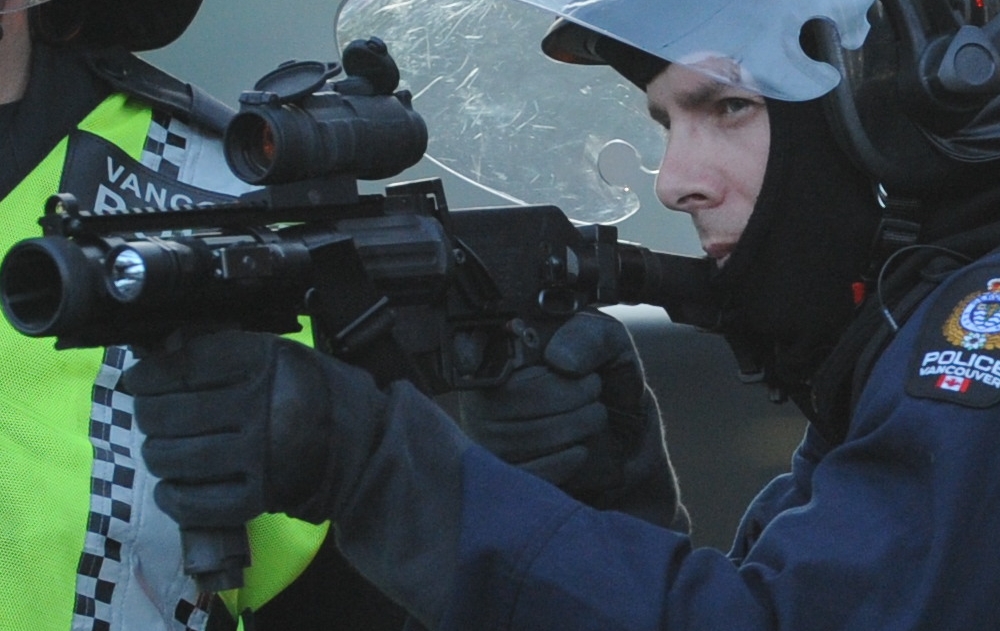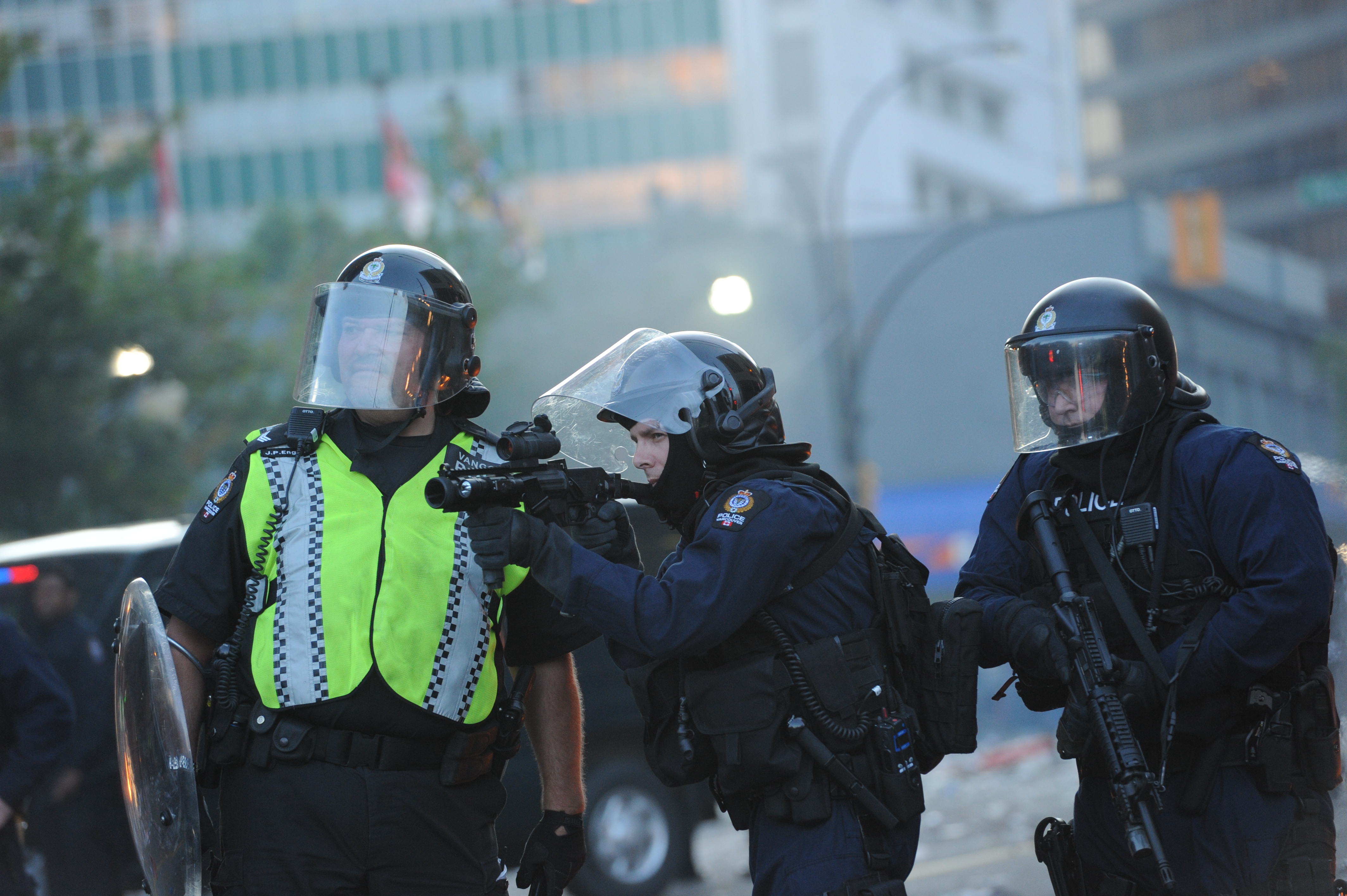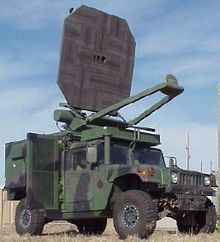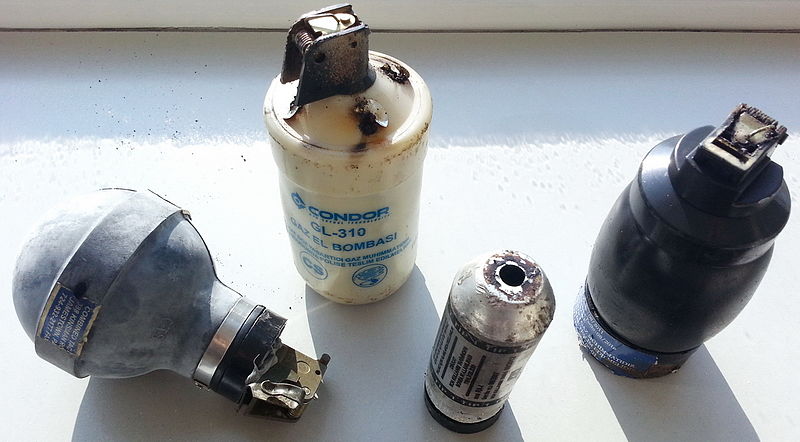|
The Servants of the People (Governments, Parliaments) Have Been Arming their "Security" Forces Against the People for Decades Already. There are many ways to deal with crowds. In the past, absolutist monarchies, like the Prussian monarchy in the days of March, 1848, used the cavalry - and its dragoons and ulans had no scruples to hit out at peaceful demonstrators or passers-by with their sabres. In our time, governments also relied on brute force repeatedly.
In November 1918, the Social-Democratic government of the young German
republic ordered reactionary monarchist Reichswehr troops to use live ammunition
when facing revolutionary workers. Captured workers often were shot on
the spot.
In the United States, the authorities had no scrupels
to deal with peaceful dissidents in a brutal way. In 1970, for instance,
the Ohio National Guard opened fire on students demonstrating peacefully
on campus. The guardsmen fired 67 rounds over a period of 13 seconds, killing
four students and wounding nine others, one of whom suffered permanent
paralysis. The shooting became known internationally as the Kent State
massacre.
Mechanical force against demonstrators: Water cannons and rubber bullets. More recently, peaceful demonstrators faced police violence in many places around the world, from Barcelona (Catalonia, Spain) and Cairo (Egypt) to Istanbul (Turkey), Oakland (California, USA) and Stuttgart (Germany), to name just a few locations. These days, the forces of (dis-)order and (in-)security do not necessarily use live ammo. "Democratic" government repression of peaceful dissent mostly relies on more sophisticated, but not necessarily non-lethal weapons. The water cannon truck is mildly "sophisticated"; it relies
on the mechanical force of the jet of water directed at peaceful crowds.
But when demonstrators are confronted by it in winter, pneumonia can easily
result from getting soaking wet.
The use of water cannons against demonstrators has resulted
in loss of eyesight (eyes washed out of eye socket), as in Stuttgart (Germany).
The force of the jet of water also has the potential to kill people with
heart conditions. On some occasions, people have been run over by such
trucks during demonstrations, with fatal results.
Those present in Vancouver during the G-7 summit will remember that the police fired rubber bullets at demonstrators.
So-called "sophisticated" and "innovative" crowd control weapons, including tasers, sonar weapons and heat rays (Active Denial Systems).
Use of this weapon has resulted at times in the death
of the victim.
Sonic and ultrasonic weapons (USW) are weapons that use sound to injure, incapacitate, or kill. Sonic weapons are currently used by military and police forces. Damage within the ear can result in internal bleeding and subsequent death.
The Active Denial System (ADS) is a directed-energy weapon
developed by the U.S. military for crowd control and certain military purposes.
The weapon is also called the heat ray; it can heat the clothing
and skin of targeted people to painful and intolerable levels. Raytheon
is currently marketing a reduced-range version of this technology. On August
20, 2010, the Los Angeles Sheriff's Department announced its intent to
use this technology on prisoners in the Pitchess Detention Center in Los
Angeles. They intended to use it for breaking up prisoner fights
- describing their immediate aim as an "operational evaluation" of
its usefulness in controlling a crowd.
AMONG ALL OF THESE WEAPONS, TWO "CROWD CONTROL" WEAPONS ARE PROBABLY THE MOST LETHAL, STATISTICALLY: GUNS THAT USE RUBBER RESPECTIVELY PLASTIC BULLETS AND TEAR GAS GRENADE LAUNCHERS. Rubber bullets that are widely used by police and paramilitary police units in order to "disperse" (or to punish) demonstrating crowds are not harmless at all. They do not just hurt, they actually have killed targeted people quite frequently. This website
List of People Killed by 'Rubber' and 'Plastic' Bullets
Rowntree, Francis
Molloy, Tobias
Friel, Thomas
Geddis, Stephen
Stewart, Brian
Donnelly, Michael
Whitters, Paul
Livingstone, Julie
Duffy, Henry
Kelly, Carol Anne
McCabe, Nora
Doherty, Peter
McGuinness, Peter
McConomy, Stephen
Downes, Sean
White, Keith
Duffy, Seamus
(Source: http://cain.ulst.ac.uk/issues/violence/rubberplasticbullet.htm)
The above document should make clear that indeed the harmless
sounding "rubber" and "plastic" ammunition fired by guns that the police
is using to "cope" with crowds are not harmless. To say that rubber bullets
and plastic bullets are "certainly non-lethal" amounts to uttering an untruth,
an outright lie. They are dangerous; they can cause bad wounds, and they
can be lethal.
The same is true when the police fires tear gas cannisters
into the crowd.
Just imagine your head being hit with great force by such
an object. People hit by it have died.
During the Cairo demonstrations against the Mubarak regime,
the (in-)security forces of that dictatorship used a particularly dangerous
type of teargas, made in U.S.A. At the time, longshoremen in the port of
Alexandria refused to unload new supplies destined for the forces that
brutally suppressed the people. These new supplies had just arrived from
the United States.
The above photo shows a Polish tear gas grenade launcher.The Western models don't look quite as shoddy. It's a big and lucrative market, with lots of demand. In fact, supplying the forces of global (dis-)order with such hardware means good business for armsmakers. It is clear that civil rights are not upheld when peaceful demonstration are infiltrated by police agents, provocateurs that commit acts of vandalism in order to create a pretense for the use of police violence against the crowd. Likewise, neutral witnesses have often observed unprovoked police violence, as in Stuttgart during the S-21 demonstrations, and in Genova (where police entered a house at night and roughed up sleeping participants in the demonstration against the G-7 summit). The arming of the police with such weapons as are shown here contradicts the purpose of a police force in a democracy. We CAN NOTICE, in several Western democracies, THE MILITARIZATION OF THE POLICE as a process that has gone on since the late 1960s. It fits into this picture that various governments, including the U.S.government, the French government, the government of the United Kingdom, the German government, and the Italian one (in this latter case, I'm speaking of the now defunct Berlusconi regime), are bent on legalizing - or have already informally accomplished - the use of the armed forces "at home," rather than exclusively abroad. Such use of the army was deemed unconstitutional not too long ago. This is not an acceptable development and the population needs to wake up and tell their elected representatives that by aiming at this deployment and use of the army within the country, they are crossing a red line. - Monique Hamburger
go back to Art
in Society # 14, Contents
* |
Crediting images used
. |
